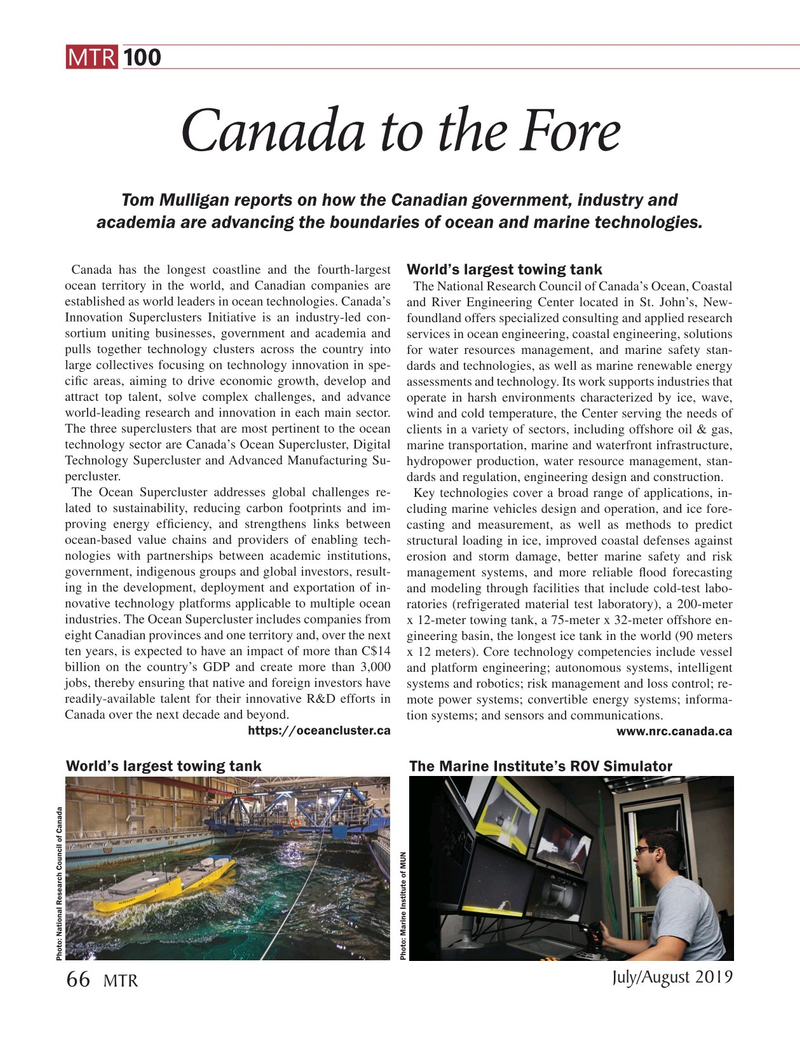
Page 66: of Marine Technology Magazine (July 2019)
MTR White Papers: Hydrographic
Read this page in Pdf, Flash or Html5 edition of July 2019 Marine Technology Magazine
MTR 100
Canada to the Fore
Tom Mulligan reports on how the Canadian government, industry and academia are advancing the boundaries of ocean and marine technologies.
Canada has the longest coastline and the fourth-largest
World’s largest towing tank ocean territory in the world, and Canadian companies are The National Research Council of Canada’s Ocean, Coastal established as world leaders in ocean technologies. Canada’s and River Engineering Center located in St. John’s, New-
Innovation Superclusters Initiative is an industry-led con- foundland offers specialized consulting and applied research sortium uniting businesses, government and academia and services in ocean engineering, coastal engineering, solutions pulls together technology clusters across the country into for water resources management, and marine safety stan- large collectives focusing on technology innovation in spe- dards and technologies, as well as marine renewable energy ci? c areas, aiming to drive economic growth, develop and assessments and technology. Its work supports industries that attract top talent, solve complex challenges, and advance operate in harsh environments characterized by ice, wave, world-leading research and innovation in each main sector. wind and cold temperature, the Center serving the needs of
The three superclusters that are most pertinent to the ocean clients in a variety of sectors, including offshore oil & gas, technology sector are Canada’s Ocean Supercluster, Digital marine transportation, marine and waterfront infrastructure,
Technology Supercluster and Advanced Manufacturing Su- hydropower production, water resource management, stan- percluster. dards and regulation, engineering design and construction.
The Ocean Supercluster addresses global challenges re- Key technologies cover a broad range of applications, in- lated to sustainability, reducing carbon footprints and im- cluding marine vehicles design and operation, and ice fore- proving energy ef? ciency, and strengthens links between casting and measurement, as well as methods to predict ocean-based value chains and providers of enabling tech- structural loading in ice, improved coastal defenses against nologies with partnerships between academic institutions, erosion and storm damage, better marine safety and risk government, indigenous groups and global investors, result- management systems, and more reliable ? ood forecasting ing in the development, deployment and exportation of in- and modeling through facilities that include cold-test labo- novative technology platforms applicable to multiple ocean ratories (refrigerated material test laboratory), a 200-meter industries. The Ocean Supercluster includes companies from x 12-meter towing tank, a 75-meter x 32-meter offshore en- eight Canadian provinces and one territory and, over the next gineering basin, the longest ice tank in the world (90 meters ten years, is expected to have an impact of more than C$14 x 12 meters). Core technology competencies include vessel billion on the country’s GDP and create more than 3,000 and platform engineering; autonomous systems, intelligent jobs, thereby ensuring that native and foreign investors have systems and robotics; risk management and loss control; re- readily-available talent for their innovative R&D efforts in mote power systems; convertible energy systems; informa-
Canada over the next decade and beyond. tion systems; and sensors and communications.
https://oceancluster.ca www.nrc.canada.ca
World’s largest towing tank The Marine Institute’s ROV Simulator
Photo: Marine Institute of MUN
Photo: National Research Council of Canada
July/August 2019 66
MTR
MTR #6 (66-79).indd 66 7/23/2019 9:39:02 AM

 65
65

 67
67
